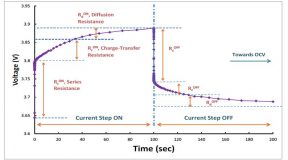Scott Baer, Marketing Manager – Batteries
Emerson Network Power, Liebert Services
The UPS that supports critical systems is only as reliable as its batteries. While seemingly low-tech, they require the utmost in care and attention to avoid the costly consequences of unplanned downtime. Emerson Network Power customer surveys have shown that more than a third of down units are due to battery failure. In fact, a single bad cell in a string of batteries could compromise the entire backup power system and leave an organization without protection.
No critical facility can justify such vulnerability. Batteries are a minimal investment when it comes to the total cost of a facility, yet they provide a substantial return on investment, protecting the overall business operation. Furthermore, taking steps to reduce the potential for battery malfunction or failure, combined with 24/7 remote battery monitoring, can virtually eliminate the unnecessary risk. Most facility managers approach battery maintenance using one of four approaches: reactive, time-cycle, predictive or proactive.
A reactive or break/fix approach is the riskiest method for determining the health of a battery string. In this case, corrective action is only taken when an outage occurs. This is often the approach used when the consequences of downtime aren’t viewed as business critical or the budget is very limited.
With a time-based approach, facilities receive regular preventive maintenance visits in which batteries are visually inspected and serviced. This is much better than no preventive action, but does not allow for battery oversight outside of these periodic visits. This approach is still risky because of external factors that can cause a significantly shorter service life than what is expected by the critical facility manager.
Implementing a predictive approach combines battery monitoring with regular preventive maintenance visits which adds a layer of protection. With mobile or embedded monitoring technology, technicians are able to measure AC impedance and DC resistance. AC impedance testing is generally more affordable because the resolution of testing data is not as accurate as when testing DC resistance—an approach that often leads to a better total cost of ownership.
- With AC impedance, an AC signal is injected into the DC battery. This will not always give an accurate picture because DC bus noise will affect an AC test signal. It also is not helpful in providing advance warning that the battery’s internal resistance is increasing, which is a sign of battery degradation. When a warning is finally given, the battery is already compromised.
- With DC resistance, a momentary load is applied while the battery voltage is monitored to ensure the battery isn’t put in a state of discharge. The battery’s internal resistance can be measured as the current flows through it. The test is stopped before the battery crosses the open circuit voltage (OCV) level. Determining the battery’s health in this manner is consistent with how a battery is designed to function. This is the approach that most accurately measures internal resistance.
While this approach has many benefits, it doesn’t offer visibility into the performance of a battery string outside of a preventive maintenance visit. Adding another layer of protection is highly recommended.
The proactive approach is the most reliable and effective method of mitigating battery risk. This approach uses regular battery testing and the same embedded UPS battery monitoring that may be used in the predictive approach. However, the proactive approach combines testing and monitoring with remote services. It gives infrastructure experts complete visibility into all pre-established critical battery parameters—cell voltage, internal resistance, cycle history, overall string voltage, current and temperature.
Additionally, remote monitoring allows for real-time diagnosis and near instant notification when a problem occurs. When actual performance data falls outside of the established parameters, signaling performance degradation, an alert can be transmitted to power system engineers and/or product experts who assess the situation through data analysis. This in turn can generate a work order to inspect, repair or replace the part that caused the alert.
A proactive approach allows infrastructure experts to detect weak batteries before they ever become bad batteries making mean time to repair (MTTR) a non-issue. Batteries are simply replaced before failure occurs. Mean time between failures (MTBF) is also improved as facility managers know the true health of their batteries which allows them to utilize those critical assets longer and with confidence.
Batteries represent the least reliable component in the critical power system. They are an electrochemical device with a finite lifespan and lose capacity over time. Adverse conditions such as over cycling, excessive charge current and high temperatures accelerate this aging process. But these conditions need not lead to the adverse effects of unplanned downtime. In tandem with a well-defined process for preventive maintenance and replacement, monitoring can help facility managers extend the service life of batteries, significantly reducing the risk of dropped loads and ensuring system availability.










